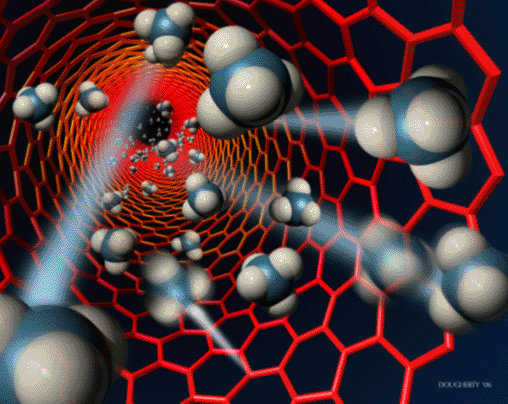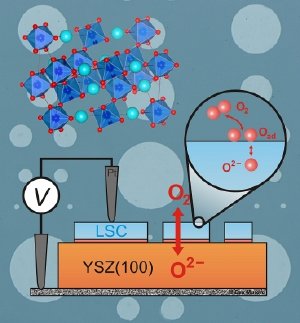Over the last decade, nanotechnology has received lots of attention from within society as a potential source for novel solutions to many of the world's existing and emerging problems. Simply put, nanotechnology could provide the ability to better understand and design complex solutions on an atomic and molecular scale. The most attractive nanotechnology-related nanomaterial is considered to be one-dimensional carbon nanotubes (CNT).
Geometrically, CNT can be visualized by rolling sheets of graphene into a long hollow tubule. The unique configuration of this material imparts excellent physico-chemical properties
1. For instance, the Young's modulus of CNT is stiffer than any other material, while their tensile strength is 100 times that of steel. Maximal electrical current density is 100 times greater than for copper wire and carrier mobility is ca. 105 cm
2/Vs. CNTs show great promise in numerous applications in the near future
2 and the excellent properties of CNT have already resulted in their use in commercial available products.
At present, the total amount of CNTs produced commercially from around the world reached ca. 1,000 ton/year. In this feature article, the basic structure of CNTs is briefly described, as well as the latest advances in the large-scale production, existing commercial uses of nanotubes are reviewed with special emphasis on the toxicological issue of CNTs.
What is a Carbon Nanotube?
CNT can be visualized as rolling sheets of graphene (sp2 carbon honeycomb lattice) into a cylinder of nanometer size diameter (Fig. 1 (a)). The structure of CNT has been explored in the early years with high-resolution transmission electron microscopy (Fig. 1 (b))
3, and the results obtained reveal that nanotubes are seamless nanoscale tubules derived from the honeycomb lattice representing a single atomic layer of crystalline graphite, otherwise referred to as a graphene sheet. The curvature of the nanotubes incorporates a small amount of sp3 bonding so that the force constant in the circumferential direction is slightly weaker than along the nanotube axis.
.jpg) |
Figure 1. (a) CNT could be visualized by rolling sheets of graphene (sp2 carbon honeycomb lattice) into a cylinder of nanometer size diameter. (b) The structure of CNT has been explored early on by high-resolution transmission electron microscopy . |
Since single-walled carbon nanotube (SWNT) is only one atom thick and has a small number of atoms around its circumference, only a few wave vectors are needed to describe the periodicity of the nanotubes. These constraints lead to quantum confinement of the wave functions in the radial and circumferential directions, with plane wave motion occurring only along the nanotube axis, corresponding to a large number or closely spaced allowed wave vectors.
Carbon nanotubes can be either metallic or semiconducting, and likewise the individual constituents of multi-wall nanotubes or single-wall nanotube bundles can be metallic or semiconducting
4. These remarkable electronic properties follow from the electronic structure of 2D graphite under the constraints of quantum confinement in the circumferential direction.
In the case of multi-walled carbon nanotubes (MWNTs), which typically have a diameter less than around 100 nm, no graphitic three-dimensional stacking is established
5, even though an individual shell of the multi layers consists of perfect graphene sheets. Also, each tube has different and independent chirality, which might contribute to a larger inter-shell spacing than is found in graphite. These characteristic structures of single- and multi-walled CNTs indicate that they are unique one-dimensional materials with fascinating electronic, chemical, mechanical, and thermal properties.
Industrial Scale Production of Carbon Nanotubes
Up until now, various synthetic methods for producing CNTs have been reported (e.g., arc discharge, laser vaporization and catalytic chemical vapor deposition (CVD)). The dominant recent trend is to synthesize CNTs using CVD approach since this technique is extremely useful for the large-scale production of both SWNTs and MWNTs
3. By simultaneously feeding hydrocarbons and nanoscale catalytic particles in the gas phase into the reaction chamber, CNTs have been synthesized on a large-scale
6.
Growing SWNTs and MWNTs in a reactor has been proposed and this involves the catalytic deposition of hydrocarbons over the surface of nano-sized metal particles and a continuous output by the particle of well-organized tubule of hexagonal sp2-carbon
3,6. The strong evidence of this assumption is the presence of catalytic particles at the ends (top or root) of the tubes (Fig. 2 (a-c)). In the case of large-scale production of SWNTs, the development of the high-pressure carbon monoxide process gave impetus to the scientific study and applications of SWNTs
7.
.jpg) |
Figure 2. shows the presence of catalytic particles at the ends of the tubes. |
Regarding the bulk production of MWNTs for industrial applications, it is important to mention that at the end of 1980, Showa-Denko Co. Ltd and Hyperion Catalysis International, Inc. (Cambridge, MA) commenced production of several tons of catalytically grown CNTs annually. At present, the total amount of the commercially available MWNTs around the world has reached 1,000 ton/year. It is expected that the global carbon-nanotube revenue in 2015 will reach US$500 million
8. The most interesting point is that all companies selected a catalytic CVD method for the large-scale production of MWNTs.
Application of Carbon Nanotubes
Due to their small dimensions and excellent physicochemical properties, CNTs have been proposed for a wide range of applications. Some of the potential applications of CNT include multi-functional composites, electrochemical electrodes and/or additives, field emitters as well as nano-sized semiconductor devices
2. CNTs are also used as fillers in both anode and cathode materials of lithium-ion secondary batteries
9,10.
MWNTs can be used as scanning probe microscope tips to obtain high-resolution images and in the near future, thin MWNTs will be used as field emission electron sources for flat-panel displays. Chemically functionalized MWNTs also give a high sensing ability for chemical and biological groups interacting with different surfaces.
In addition, CNTs are an ideal candidate for fillers in polymer composites. The smallest working composite gear has been prepared by mixing nanotubes into molten nylon and then injecting into the tiny mold. This piece exhibits a high mechanical strength, high abrasion resistance and also good electrical and thermal conductivity. Further progress has to be carried out in order to fully utilize these nanotube/polymer composites, for example the optimization of surface properties, the homogeneous dispersion without physical damage, the development of an effective alignment method (also evaluation method) and processing.
A super rubber sealant capable of withstanding high temperature and pressure was successfully fabricated by Professor Morinobu Endo and his colleagues at the
Institute of Carbon Science & Technology. This was done by incorporating surface-modified nanotubes into rubber
11. Based on our estimates and after surveying the depth and temperature of oil resources, the development of a super rubber technology capable of withstanding 260°C under 239 MPa of pressure will contribute to a revolutionary enhancement in oil recovery efficiency from the current 35 % to more than 70 % by excavating previously inaccessible deposits.
Another potential application of CNT is in the fabrication of super-capacitors and electrochemical actuators used in artificial muscles. Nanotube actuators can operate at low voltages and temperatures as high as 350°C. Currently, super-capacitors are incorporated into hybrid vehicles as they could provide rapid acceleration and store breaking energy electrically.
The possibility of using CNTs as nanowires is envisaged due to their observed ballistic transport. For the fabrication of nanotube field effect transistors, SWNTs were connected to metal nano-electrodes. The performance is excellent in terms of switching speed owing to their low capacitance. An inherent problem associated with CNT lies in the difficulty in manipulating them. From a commercial viewpoint, further technical progress is required, such as selective growth of nanotubes using self-assembly techniques.
Carbon Nanotube Biocompatibility
Much attention was paid on the toxicity of CNTs due to their nanoscale dimension and their morphological features similar to that of asbestos
12,13. Therefore, toxicological evidence of CNT is strongly needed to prevent risks and occupational disorders in workers and to promote their safe use in consumer products. Our preliminary studies on the biological response of CNTs indicates their potential toxic nature is significantly low
14,15. However, a more thorough and long-term study has to be conducted to determine the toxic nature of various types of CNTs such as direct aspiration of tubes in human lungs.
OUTLOCK
These tiny, black and tubular-type nanomaterials will change the way we live, work and communicate. A large number of CNT-derived products are already in use and their viability strongly depends on the success of their commercialization.
Before considering the use of CNTs in commercial products as a success, at least four obstacles have to be resolved:
1. How to obtain high purity CNTs as metallic impurities often remain after the fabrication process which can give rise to toxic properties.
2. How to manipulate these tiny materials.
3. How to control the chirality of CNT.
4. The most important but critical "safety" issue has to be clarified based on long-term and systematic biological studies.
Extensive and intensive efforts in both academy and industry are looking for a solution to these obstacles and once a solution has been reached, CNTs will play a key important role as an innovative material of 21st century in a number of industrial processes.
We have reached beyond the first mountain of science, the second mountain of technology and the third mountain of economy by producing CNTs successfully on a large-scale at reasonable cost (Fig. 3). Now we are striving to climb the mountain of society. By sharing information on risks and benefits of CNTs with all stakeholders, we will finally reach the top of a nanotube mountain and prove CNT is an innovative material for the 21st century.
.jpg) |
Figure 3. Carbon nanotube as a leading-edge of nanotechnology must go beyond the four mountains as an innovative and fundamental technology of 21st century. Worldwide collaboration on science is the key issue for the success. |
Acknowledgement
This work was in part supported by the CLUSTER (second stage) and MEXT grants (No 19002007), Japan.
References
1. M.S. Dresselhaus, G. Dresselhaus and P.C. Eklund, Science of Fullerenes and Carbon Nanotubes, Academic Press, San Diego (1996).
2. M. Endo, M. S. Strano, P. M. Ajayan, In Carbon Nanotubes: Advanced Topics in the Synthesis, Structure, Properties and Applications (Eds, A. Jorio, M. S. Dresselhaus, G. Dresselhaus), Springer, 2008, pp 13-61.
3. A. Oberlin, M. Endo and T. Koyama, J. Crystal Growth 32, 335-349 (1976).
4. R. Saito, M.S. Dresselhaus and G. Dresselhaus, Physical Properties of Carbon Nanotubes, Imperial College Press, London (1998).
5. X. Sun, C.H. Kiang, M. Endo, K. Takeuchi, T. Furuta and M.S. Dresselhaus, Phys. Rev. B 54, 1 (1996).
6. M. Endo, Chem. Tech. 568-576 (1988).
7. P. Nikolaev, M. J. Bronikowski, R. K. Bradley, F. Rohmund, D. T. Colbert, K. A. Smith, R. E. Smalley, Chem. Phys. Lett. 313, 91 (1999).
8. Business Watch, Nature 461, 703 (2009).
9. M. Endo, Y.A. Kim, T. Hayashi, K. Nishimura, T. Matushita, K. Miyashita and M. S. Dresselhaus, Carbon 39, 1287-1297 (2001).
10. C. Sotowa, G. Origi, M. Takeuchi, Y. Nishimura, K. Takeuchi, I. Y. Jang, Y. J. Kim, T. Hayashi, Y.A. Kim, M. Endo, M. S. Dresselhaus, ChemSusChem 1, 911-915 (2008).
11. M. Endo, T. Noguchi, M. Ito, K. Takeuchi, T. Hayashi, Y.A. Kim, T. Wanibuchi, H. Jinnai, M. Terrones, M.S. Dresselhaus, Adv. Funct. Mater. 18, 3403-3409 (2008).
12. A. Takagi, A. Hirose, T. Nishimura, N. Fukumori, A. Ogata, N. Ohashi, S. Kitajima, J. Kanno, J. Toxicol. Sci. 33, 105-116 (2008).
13. C. A. Poland, R. Duffin, I. Kinloch, A. Maynard, W. A. H. Wallace, A. Seaton, Nat. Nanotech. 3, 216-221 (2008).
14. S. Koyama, M. Endo, Y.A. Kim, T. Hayashi, T. Yanagisawa, K. Osaka, H. Koyama, N. Kuroiwa, Carbon 44, 1079-1092 (2006).
15. S. Koyama, Y.A. Kim, T. Hayashi, K. Takeuchi, C. Fujii, N. Kuroiwa, H. Koyama, T. Tukahara, M. Endo, Carbon 47, 1365-1372 (2009).
Copyright AZoNano.com, Professor Morinobu Endo (Shinshu University)
Date Added: Jun 23, 2010 















 3:18 AM
3:18 AM
 Afdhal Atiff Tan
Afdhal Atiff Tan






.jpg)
.jpg)
.jpg)
.jpg)







